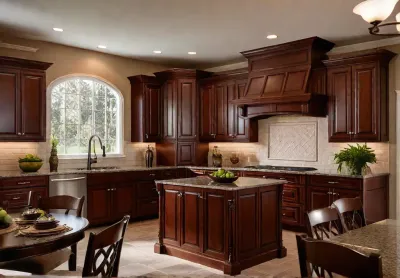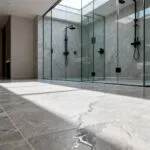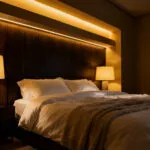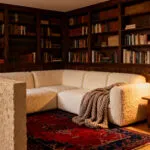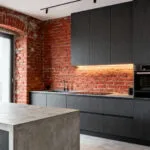Stepping into a traditional kitchen should feel like being enveloped in a warm embrace – a space that invites you to linger, create, and make memories. As an expert in heritage design and a true connoisseur of the timeless, I firmly believe that the key to achieving this lies in the thoughtful selection of wood tones for your kitchen cabinets.
From the rich, luxurious allure of cherry wood to the light, versatile charm of maple, each variety offers its distinct character and aesthetic appeal. It’s a delicate dance between honoring the past and embracing modern sensibilities, a harmonious blend of heritage and livability.
In this exploration of wood tones for traditional kitchen cabinets, I invite you to embark on a journey of discovery. We’ll delve into the nuances of each wood variety, uncovering their unique personalities, practical considerations, and design possibilities. Together, we’ll unravel the secrets to creating a kitchen that transcends mere functionality, becoming a sanctuary where warmth, elegance, and timeless beauty converge.
Cherry Wood: Timeless Beauty and Rich Hues
As a lover of warm, inviting spaces, I find cherry wood an absolute gem for traditional kitchen cabinets. Its rich reddish-brown tones and smooth, elegant grain exude timeless beauty that instantly elevates any culinary haven. Moreover, cherry wood can remarkably deepen and develop character over time, adding depth and charm to your cabinets with every passing year.
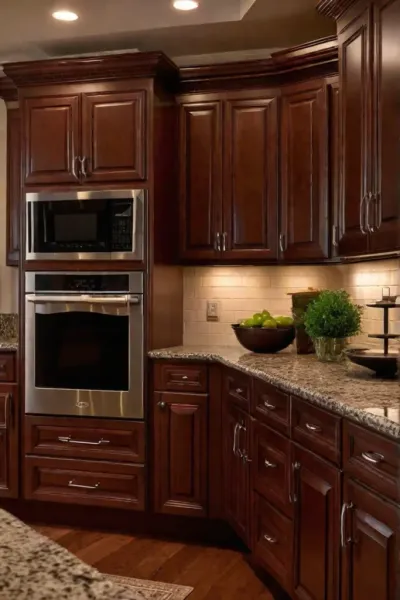
Choosing the Right Cherry Wood
One of the many joys of working with cherry wood is the ability to customize its final look through various stain options. Whether you prefer a lighter, more contemporary feel or a deeper, more traditional richness, a cherry wood stain will suit your desired aesthetic perfectly. I always recommend exploring samples and visualizing how each option will complement the other design elements in your kitchen.
Pairing Cherry Cabinets with Other Design Elements
When it comes to pairing cherry cabinets with other design elements, the possibilities are endless. Consider warm-toned countertops like granite or quartz for a warm and cohesive look. And for hardware, nothing quite complements the richness of cherry wood like bronze or brass finishes. Trust me, the combination is simply stunning.
Interestingly, cherry wood has been prized for its durability and elegance in furniture making for centuries, making it a natural choice for kitchen cabinetry. As a practical tip, lighter cherry stains can lend a more contemporary feel, while darker stains offer a more traditional, cozy vibe.
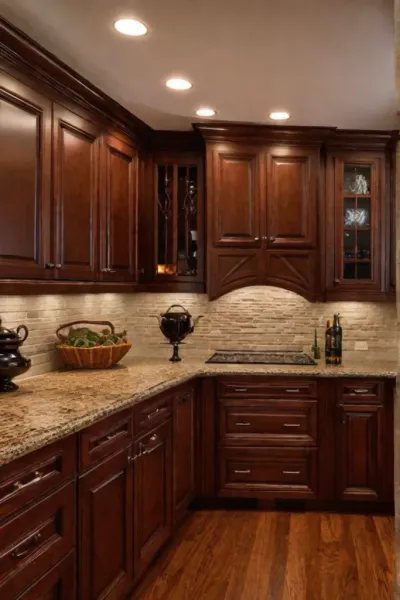
There are typically three main options for the different grades of cherry wood available for cabinetry: select, premium, and rustic. Select cherry is the most consistent in color and grain pattern, while premium offers more variation and character. Rustic cherry, on the other hand, embraces knots and mineral streaks for a more rustic, organic look.
In essence, cherry wood cabinets offer a classic and luxurious aesthetic that can be tailored to suit various design preferences, making them a true gem for traditional kitchens.
The warmth and elegance of cherry wood seamlessly transition to the next section, where we’ll explore the lightness and versatility of maple wood.
Maple Wood: Lightness and Versatility
As an expert in home decor, I can’t help but swoon over maple wood’s natural allure. It’s light, creamy hue and fine, even grain creates a sense of warmth and elegance that instantly elevates any traditional kitchen.
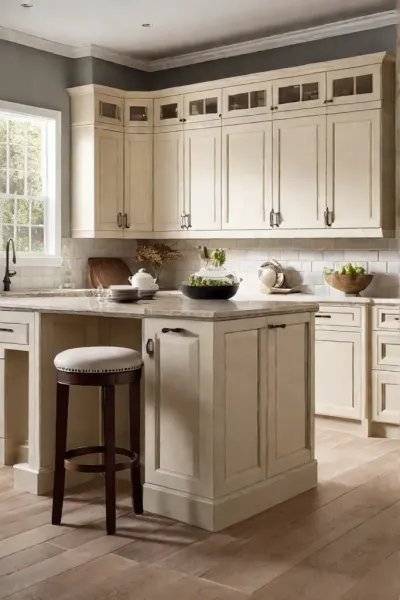
Exploring Maple Wood Varieties
Maple comes in two main varieties: hard and soft. Hard maple boasts exceptional durability, making it an ideal choice for high-traffic kitchens. Its resilience to scratches and dents ensures your cabinets maintain a pristine appearance for years. Soft maple, on the other hand, offers a more subtle grain pattern, lending itself beautifully to painted finishes.
Contrasting with Maple: Creating Visual Interest
One of the joys of working with maple wood is its versatility. Its neutral canvas allows you to experiment with various stains and finishes, tailoring the look to your style. Consider pairing maple cabinets with darker countertops, such as granite or soapstone, for a striking contrast. This bold juxtaposition adds depth and visual interest to your kitchen’s design.
Maple wood’s versatility extends beyond its aesthetic appeal. Did you know it’s often used for cutting boards due to its hardness and resistance to bacteria? This practical aspect makes it a fantastic choice for kitchen cabinetry, ensuring a hygienic and long-lasting investment.
The pros of using maple wood for kitchen cabinets outweigh the cons. While it may not boast the bold grain patterns of some hardwoods, its durability and resistance to wear and tear make it a practical choice for busy households. Additionally, its light color creates a sense of airiness and spaciousness, perfect for brightening up your traditional kitchen.
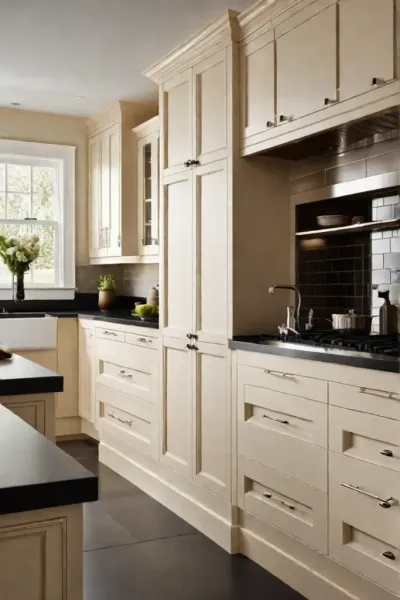
Remember, the key to a successful maple wood kitchen lies in the details. Pair hard maple with high-traffic areas for maximum durability, while soft maple lends itself beautifully to painted finishes. And don’t be afraid to play with contrasting elements, like darker countertops, to create a visually striking and cohesive design.
With its versatility and timeless appeal, maple wood is a true gem in traditional kitchen cabinetry. Embrace its warmth and elegance, and let it be the canvas for your culinary haven.
Oak Wood: Strength and Rustic Charm
As a lover of traditional design, I can’t help but swoon over the warm and inviting allure of oak wood. With its prominent grain pattern and honey-like hues, oak brings a rustic charm that instantly makes a kitchen feel like a cozy haven.
Choosing the Right Oak for Your Style
One of the beauties of oak is the variety of finishes it offers. You can opt for a light stain accentuating the wood’s natural warmth or a deeper, aged look that exudes old-world elegance. The choice is yours, and it’s all about finding the perfect match for your style.
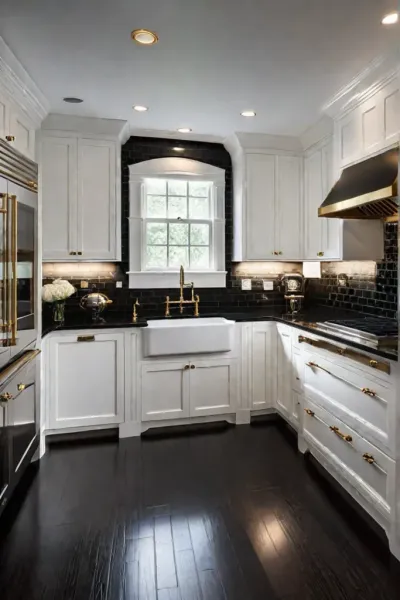
Enhancing Oak’s Natural Beauty
While oak is stunning, there are ways to elevate its natural beauty even further. Consider distressing or wire-brushing the cabinets for a rustic aesthetic that adds character and depth. And don’t be afraid to pair your oak cabinets with natural stone countertops or a brick backsplash. These elements will create a warm and inviting atmosphere perfect for traditional kitchens.
No wonder oak has been a beloved choice for construction and furniture making for centuries. Its strength and durability make it ideal for long-lasting cabinetry that can withstand the wear and tear of daily life. And let’s not forget the visual impact—that prominent grain pattern is a true showstopper!
When it comes to oak, you have options galore. Red oak boasts a more pronounced grain and reddish hue, while white oak has a tighter grain and a lighter color. Whichever you choose, you can rest assured that your oak cabinets will add a touch of rustic elegance and timeless appeal to your traditional kitchen.
How does the grain pattern of oak wood affect the overall look of kitchen cabinets? The prominent grain pattern is a defining feature of oak, adding depth, texture, and visual interest to the cabinetry. It’s a key element that contributes to the rustic charm and warmth that oak is known for.
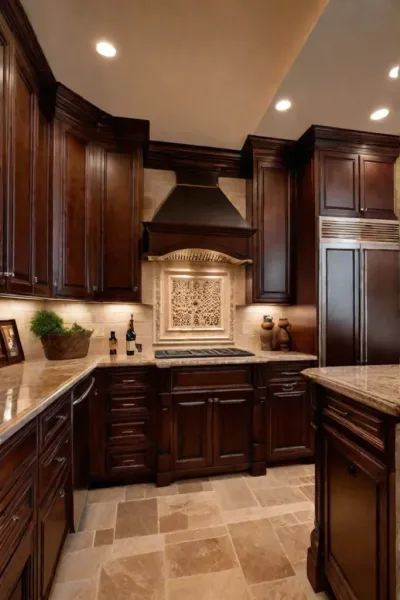
In essence, oak wood is a true classic that never goes out of style. Its durability ensures that your cabinets will withstand the test of time, while its natural beauty creates a welcoming and inviting atmosphere that’s perfect for traditional kitchens.
Walnut wood, with its deep tones and sophistication, is up next – a rich and luxurious choice that promises to elevate your kitchen’s elegance to new heights.
Walnut Wood: Deep Tones and Sophistication
Ah, walnut wood – the epitome of luxury and sophistication in kitchen cabinetry. Its rich, dark brown hues and striking grain patterns exude a warmth that instantly elevates any space. Let me guide you through the allure of this timeless wood tone.
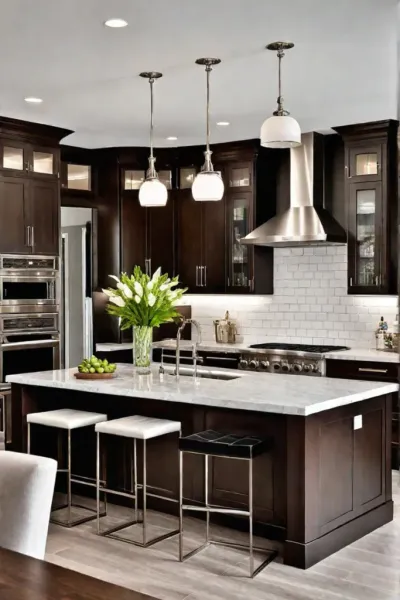
The Allure of Walnut
Walnut wood’s depth and character are simply unmatched. Its tones range from deep chocolate browns to hints of purple and black, creating a captivating visual experience. This natural beauty is often showcased in high-end furniture and musical instruments, a testament to its exceptional qualities.
Complementing Walnut’s Richness
The Walnut wood’s versatility allows it to pair beautifully with light and dark color palettes. Consider using it for your kitchen island or accent cabinets to create a stunning focal point. Pair walnut cabinets with light-colored countertops and backsplashes for a contrasting yet harmonious look. Fordware, gold, or black finishes will perfectly complement the richness of this wood tone.
Walnut wood cabinetry may be more expensive than some other hardwoods, but trust me, the investment is well worth it. Its timeless elegance and durability will elevate your kitchen for years to come.
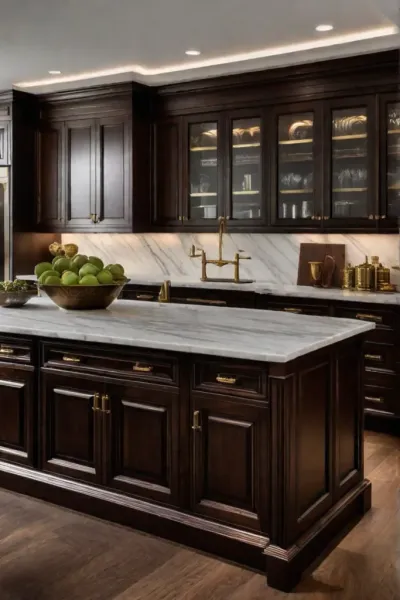
In essence, walnut wood brings a sense of warmth and sophistication to traditional kitchens. Its unique grain patterns and rich color create a statement piece in the heart of your home. Embrace the luxurious allure of walnut and let it be the star of your kitchen design.
Our next section explores the endless possibilities of painted finishes for kitchen cabinets.
Painted Finishes: Endless Possibilities
As a homeowner with an eye for detail, I can’t help but get excited about the endless possibilities that painted finishes offer for traditional kitchen cabinets. These finishes allow you to make the space your own, infusing it with your unique style and personality.
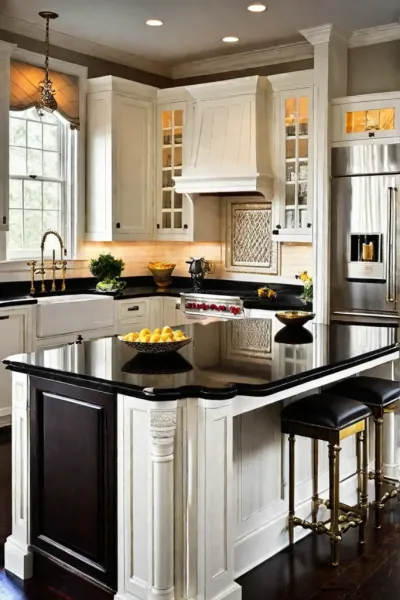
Choosing the Right Paint Color
The first step in this delightful journey is selecting the perfect paint color. Do you want to create a warm, inviting atmosphere with rich, earthy tones like sage green or terracotta? Or perhaps you prefer the crisp, clean look of a classic white or soft gray? The beauty of painted finishes lies in their versatility – you can go bold with a statement color like navy blue or keep it subtle with a neutral hue. Trust your instincts and let your taste guide you.
Exploring Painted Finish Techniques
But the fun doesn’t stop there! Painted finishes offer a world of artistic techniques to explore. Consider distressing the cabinets for a charming, vintage vibe, or add depth and dimension with a glazing technique. You could even experiment with different sheens, from a high-gloss finish for a sleek, modern touch to a matte finish for a more rustic, organic feel.
Painted kitchen cabinets have been a beloved choice for centuries, and trends have evolved over time. But one thing remains constant: their ability to transform a space and make it your own.
Regarding durability, I recommend using high-quality acrylic or oil-based paints specifically designed for cabinets and trim. These paints are formulated to withstand the wear and tear of a busy kitchen, ensuring your cabinets look beautiful for years.
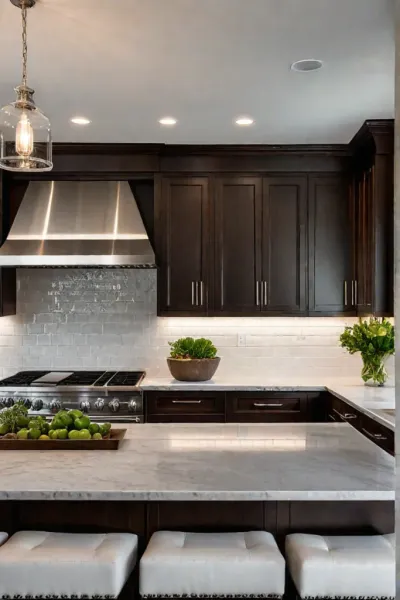
Remember, painted finishes offer versatility and endless design possibilities for traditional kitchens. They allow you to express your style and create a space that reflects your taste. So, embrace your inner artist and let your creativity shine!
Now, let’s move on to the conclusion, where we’ll tie everything together and inspire you to embark on your Kitchen Transformation.
Closing thoughts
As we end our journey through the captivating world of wood tones for traditional kitchen cabinets, I hope you feel inspired to embrace the rich tapestry of possibilities that lie before you. Whether you bask in the warmth of cherry wood, revel in the versatility of maple, or indulge in the rustic charm of oak, each choice is a testament to your unique style and the stories you wish to weave within your culinary haven.
Remember, the true magic lies in the details – the carefully curated finishes, the thoughtful pairings, and the personal touches that breathe life into these timeless materials. Trust your instincts, and let your kitchen reflect your soul. In this sanctuary, heritage and modernity intertwine in perfect harmony.
Embrace the journey, for it is in the pursuit of beauty and authenticity that we truly find ourselves at home.
